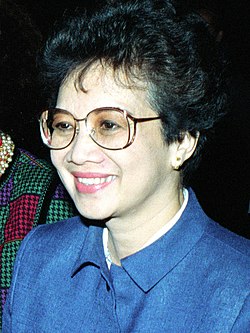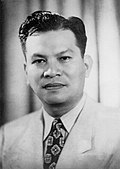List of presidents of the Philippines
list of persons by position held From Wikipedia, the free encyclopedia
Remove ads
Under the present Constitution of the Philippines, the president of the Philippines (Filipino: Pangulo ng Pilipinas) is both the head of state and the head of government, and is the commander-in-chief of the country's armed forces.
Here is the list of the country's presidents.
List of presidents of the Philippines
Aniceto Lacson
(November 5, 1898 - November 27, 1898)
November 5, 1898 - July 22, 1899
(President in Negros Occidental only until November 27, 1898)
PresidentDemetrio Larena
(November 24, 1898 - November 27, 1898)
November 5, 1898 - July 22, 1899
(President in Negros Oriental only)
Vice-PresidentJosé de Luzuriaga
July 22, 1899 - November 6, 1899President of the Chamber of Deputies Eusebio Luzurriaga Secretary of the Treasury Simeón Lizares Secretary of the Interior Nicolás Gólez Secretary of Public Works Agustín Amenábar Secretary of Agriculture and Commerce Juan Araneta Secretary of War Antonio Ledesma Jayme
July 24, 1854 - October 9, 1937Secretary of Justice Melecio Severino
November 6, 1899 - April 30, 1901Governor-General of the Provinces
Remove ads
Presidents
The colors indicate the political party affiliation of each individual.
Prior to the First Republic
The Spaniards colonized the Philippines as the Captaincy General of the Philippines. The Spanish monarchy was represented by the Governor-General from 1565 to 1898. Spain ceded all of its remaining possessions, including the Philippines, save for Cuba at the end of the Spanish–American War via the Treaty of Paris.
1899–1901: First Republic (Malolos Republic)
The First Philippine Republic was inaugurated on January 23, 1899 at Malolos, and ended on March 23, 1901 when President Emilio Aguinaldo was captured by the Americans at Palanan.
The Americans had already begun controlling areas not controlled by the First Republic after the Spanish cession. The President of the United States is represented first by military governors, then by civilian Governors-General up to 1935.
1935–46: Commonwealth
The Commonwealth was inaugurated on November 15, 1935 at Manila, and ended upon independence on July 4, 1946.
1943–45: Second Republic
The Second Republic was inaugurated on October 14, 1943 in Manila, and ended when President Jose P. Laurel dissolved the republic on August 17, 1945, in Tokyo.
1946–72: Third Republic
The Third Republic started when independence was granted by the Americans on July 4, 1946, and ended upon the imposition of martial law by President Ferdinand Marcos on September 21, 1972.
1972–87: Martial law and the Fourth Republic
President Ferdinand Marcos ruled by decree when he declared martial law on September 21, 1972. He inaugurated the "New Society" after a new constitution was ratified on January 17, 1973. He declared the Fourth Republic on January 17, 1981, after martial law was lifted.
1987–present: Fifth Republic
President Corazon Aquino inaugurated the Fifth Republic after the present constitution was ratified. The plebiscite took place on February 2, 1987.
Remove ads
Notes
- In chronological order, the presidents started with Manuel L. Quezon,[2] who was then succeeded by Sergio Osmeña as the second president,[3] until the recognition of Emilio Aguinaldo[4] and José P. Laurel's[5] presidencies in the 1960s.[subnote 1] With Aguinaldo as the first president and Laurel as the third, Quezon and Osmeña are thus listed as the second and the fourth, respectively.[1][6]
- For the purposes of numbering, a presidency is defined as an uninterrupted period of time in office served by one person. For example, Manuel L. Quezon was elected in two consecutive terms and is counted as the second president (not the second and third).[subnote 2] Upon the death of the fifth president, Manuel Roxas, Elpidio Quirino became the sixth president even though he simply served out the remainder of Roxas' term and was not elected to the presidency in his own right.
- Term ended when Aguinaldo was captured by US forces in Palanan, Isabela, during the Philippine–American War.[6][subnote 3]
- Later sought election or re-election to a non-consecutive term.[subnote 4]
- Term began with the formal establishment of the Philippine Commonwealth.[16][subnote 2]
- Died, in office, of tuberculosis in Saranac Lake, New York.[17]
- Term was originally until 15 Nov 1943, due to constitutional limitations as provided by the 1940 amendment of the 1935 Constitution, which shortened the terms of the president and the vice president from six to four years but allowed re-election.[subnote 4] Quezon was not intended to serve the full four years of the second term he won in the 1941 election because a ten-year presidency would have been considered excessive. In 1943, however, due to World War II, he and Vice President Osmeña, who was also re-elected, had to take an emergency oath of office, extending their tenure.[6][18]
- Unseated (lost re-election).[subnote 4]
- Sought an election for a full term, but was unsuccessful.
- Prior to the ratification of the 1987 Constitution, there was no mechanism by which a vacancy in the vice presidency could be filled.[12][11] Gloria Macapagal Arroyo was the first president to fill such a vacancy under the provisions of the Constitution when she appointed Teofisto Guingona Jr.
- Term began with the establishment of Japan's puppet Second Republic after it occupied the Philippines during World War II.[28][29] The Commonwealth continued its existence as a government in exile in Australia and the United States.[16][30] The Philippines had two concurrent presidents by this time:[6] a de jure (the Commonwealth president) and a de facto (Laurel).[31] Because of his status, he was not considered a legitimate president by the government succeeding the second republic until the 1960s.[5]
- Term ended when he dissolved the Second Republic in the wake of Japan's surrender to the Allies two days prior.[5][29][subnote 1] The Commonwealth was re-established in the Philippines,[28] with Sergio Osmeña as the fourth president.[6][subnote 5]
- The Third Republic began when the Philippine Commonwealth ended on 4 July 1946.[6][38]
- Deposed in the People Power Revolution.[subnote 6]
- Term ended upon Marcos' declaration of martial law.[13][subnote 7][subnote 8]
- Imposed martial law, as a self-coup, on 23 September 1972, through Proclamation No. 1081, shortly before the end of his second and final term in 1973.[subnote 7] General Order No. 1, which detailed the transfer of all powers to the president, was also issued, enabling Marcos to rule by decree.[64]
- Served concurrently as prime minister from June 12, 1978 to June 30, 1981.[60][subnote 8]
- The 1973 Constitution was amended through a plebiscite held on January 27, 1984 to re-establish the vice presidency.[13][66][subnote 8]
- The 1973 Constitution, as amended in 1981, did not place restrictions on re-election.[subnote 4]
- Assumed presidency by claiming victory in the disputed 1986 snap election.[subnote 6]
- The Supreme Court declared Estrada had resigned and thus vacate the office of the president following the Second EDSA Revolution.[73]
- Emilio Aguinaldo would be counted as the second president if he had won the 1935 election because the presidency was abolished and remained defunct until November 15, 1935. During that period, the executive power was exercised by the Governor-General of the US military government and the Insular Government, the precursor of the Philippine Commonwealth.[7]
- Before the ratification of the 1981 amendment of the 1973 Constitution, which removed the limit on re-election to the office for another six-year term,[9][10] presidents were elected to a four-year term with the possibility of re-election, as the amended 1935 Constitution specified: "No person shall serve as [p]resident for more than eight consecutive years."[11] When the 1987 Constitution was imposed and, in effect, superseded the previous constitutions, the president is no longer eligible for any re-election. It does, however, allow a person who had assumed the presidency to seek for a full six-year term if he or she has not yet "served as such for more than four years".[12]
- Ferdinand Marcos and Corazon Aquino both took their oath of office on 25 February 1986. In effect, the Philippines again had two simultaneous presidents, albeit for nine hours only.[55] Marcos was proclaimed on February 15 the winner of the widely denounced February 7 snap election,[55][56] which he called after opposition leader Benigno Aquino Jr., his chief rival and Corazon's husband, was assassinated in 1983.[57] However, in a separate NAMFREL tally dated February 16, Aquino was found the actual duly-elected president.[58][59] The events led to the People Power Revolution on February 22–25, which forced Marcos to leave to exile in Hawaii and installed Aquino to the office.[55][57][59]
- Accounts differ on when martial law was officially established. While sources such as Raymond Bonner have written that Proclamation No. 1081 was signed on 23 September 1972, Primitivo Mijares, a former journalist for Marcos, and the Bangkok Post stated that it was on September 17, only postdated to September 21 because of Marcos' numerological beliefs that were related to the number seven. Marcos claimed to have signed it on September 21, and as of 9 p.m. Philippine Standard Time (UTC+08:00) on September 22, the country was under martial law. He formally announced it in a live television and radio broadcast on September 23. The official date when martial law was set was on September 21 (because it was a date that was divisible by seven), but September 23 is generally considered the correct date because it was when the nation was informed and thus the proclamation was put into full effect.[64]
- On 17 January 1973, while martial law was still in effect, the 1973 Constitution was ratified, which suspended the 1935 Constitution and ended the Third Republic.[13][38] What Marcos called a New Society (Bagong Lipunan) began,[38] introducing a parliamentary form of government;[65] the vice presidency was abolished and the presidential succession provision was devolved to the prime minister.[13]
Remove ads
References
Wikiwand - on
Seamless Wikipedia browsing. On steroids.
Remove ads







































